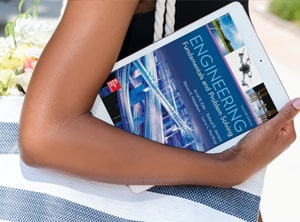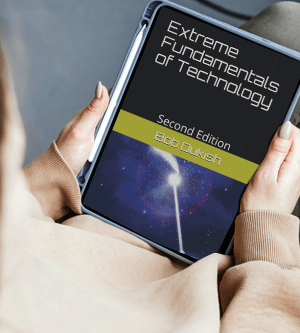

E-textbooks, also known as electronic textbooks or digital textbooks, have become increasingly popular in recent years. Traditional or print textbooks, on the other hand, have been a staple in education for generations. But which one is the better option for your college journey? The best way to figure out which is the right choice for you is to know the advantages and disadvantages of both options, so let’s explore them.

Advantages of e-textbooks
Portability and accessibility: E-textbooks are easily accessible on various devices such as laptops, tablets, e-readers, and smartphones. This unparalleled convenience means you can get them online, and you don’t have to visit a physical bookstore or library. Furthermore, you can easily carry an entire digital library in your backpack or pocket and study wherever you are.
Lower cost: E-textbooks are typically more affordable than traditional textbooks. Sometimes, they can cost up to 50% less, so you can save a significant amount of money throughout your education. You can also rent or subscribe to digital textbooks, which can be an even more budget-friendly option than buying new print editions.
Multimedia integration: E-textbooks can incorporate multimedia elements like videos, interactive diagrams or quizzes, and hyperlinks to online resources. These additions can make your learning experience more engaging and effective, helping you understand more complex concepts and enabling you to cross-reference information easily.
Easy search and annotations: E-textbooks often have search functions that allow you to find specific information within the text quickly. This feature is invaluable when you need to locate a particular keyword, paragraph, or chapter. Additionally, e-textbooks can have copy-and-paste features and digital annotations, letting you easily quote sections, highlight important passages, or add comments.

Disadvantages of e-textbooks
Distractions: You need an electronic device to read e-textbooks, and we all know how distracting laptops, tablets, or smartphones can be. It’s easy to switch from studying to browsing social media, chatting with friends, or watching videos, potentially affecting productivity.
Device dependency: Using e-textbooks means you’re dependent on your devices. If you crack your tablet screen, your laptop runs out of battery, or your device stops working, this can disrupt your study session.
Screen fatigue: Staring at screens for extended periods can lead to eye strain and discomfort. This can be a drawback if you spend long hours studying with electronic devices.

Advantages of traditional textbooks
Tactile experience: Traditional textbooks offer a tangible reading experience that e-textbooks, despite their many benefits, can’t replicate. Turning pages and physically interacting with a book can improve engagement, comprehension, and retention of information. Also, many students find the physical act of highlighting, underlining, or making margin notes conducive to their learning process.
Minimal distractions: A common issue associated with e-textbooks is the possibility of being distracted by other things on electronic devices. This isn’t a problem with print books. There are no notifications, apps, or tempting social media platforms to divert your focus, so you can immerse yourself fully in what you’re reading.
Tech independence: Traditional textbooks don’t rely on electronic devices, so there is no risk of technical disruptions during your study sessions. They are reliable learning resources you can use without worrying about running out of battery or internet connectivity issues. Plus, they are easier on the eyes and give you a chance to reduce the time you spend in front of screens anyway.
Resale value: Print textbooks have the distinct advantage of retaining their resale value. Once you have completed your studies, you can sell your textbooks, getting back a portion of their initial purchase cost. There are many places to sell your used textbooks, such as your college bookstore, directly to other students on campus or online.

Disadvantages of traditional textbooks
Heaviness and bulk: Traditional textbooks can be heavy and bulky. They can take up a significant amount of space in your dorm room or backpack. Carrying multiple books to and from classes, the library, or study sessions can be quite a hassle.
Higher Cost: Traditional textbooks tend to be more expensive, with some college textbooks costing hundreds of dollars each. The high upfront cost of purchasing new textbooks, especially for a full semester’s worth of courses, can significantly impact your budget.
Limited searchability: Finding specific information within a print textbook can be time-consuming compared to the quick search function of e-textbooks. You’ll need to flip through pages manually, scan table contents, and sometimes rely on an index to find what you’re looking for within the text.
The bottom line
The choice between e-textbooks and traditional textbooks comes down to what works best for you. Both options have their strengths and weaknesses, and there is no one-size-fits-all answer.
If you appreciate the sensory experience of holding a physical book, you want to avoid digital distractions, or your courses or professors specifically require print editions, traditional textbooks seem like the logical choice.
On the other hand, if your goal is to save money, you don’t want to lug around a heavy backpack filled with bulky books, or you are used to studying on your devices, opting for e-textbooks is likely a wise decision.
Finally, this doesn’t have to be a matter of choosing one over the other. Many students find that a combination of e-textbooks and print textbooks suits their needs perfectly.
A policy from NSSI can provide coverage not only for your expensive textbooks or valuable electronic devices but also for all your belongings, from appliances to furniture to clothing. Get a free NSSI college student property insurance quote today!












 Whether you’re living on campus or studying abroad, NSSI has you covered! From spilling coffee all over your laptop to dropping your smart phone in the parking lot, you’re covered wherever you go.
Whether you’re living on campus or studying abroad, NSSI has you covered! From spilling coffee all over your laptop to dropping your smart phone in the parking lot, you’re covered wherever you go.  Did you know that NSSI covers more than just electronics? We cover everything from clothes to textbooks, even jewelry. So whether you accidentally flushed your great- grandmother’s ring or your roommate ran over that expensive business textbook, we’ve got you covered.
Did you know that NSSI covers more than just electronics? We cover everything from clothes to textbooks, even jewelry. So whether you accidentally flushed your great- grandmother’s ring or your roommate ran over that expensive business textbook, we’ve got you covered. Do accidents seem to follow you wherever you go? Don’t worry, we can help! At NSSI we offer unlimited claims on damages to your personal property. Whether it’s a shattered laptop or a flattened smartphone, we’ve got you covered.
Do accidents seem to follow you wherever you go? Don’t worry, we can help! At NSSI we offer unlimited claims on damages to your personal property. Whether it’s a shattered laptop or a flattened smartphone, we’ve got you covered.  Got a dog that lives to destroy furniture? With coverage from NSSI, you can protect your personal property and enjoy your furry friends too. Our plans includes coverage for accidental pet damage.
Got a dog that lives to destroy furniture? With coverage from NSSI, you can protect your personal property and enjoy your furry friends too. Our plans includes coverage for accidental pet damage. 
